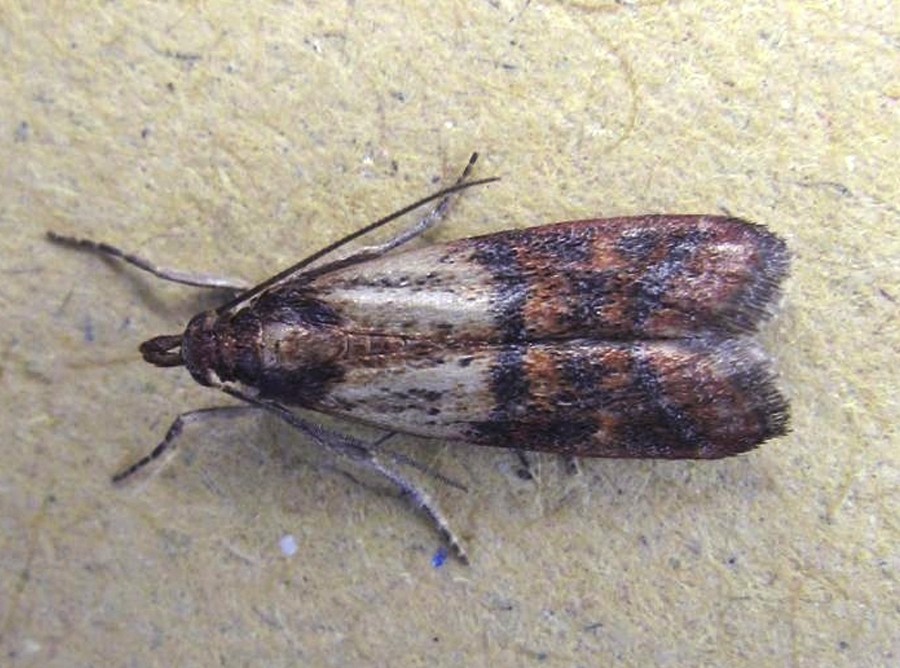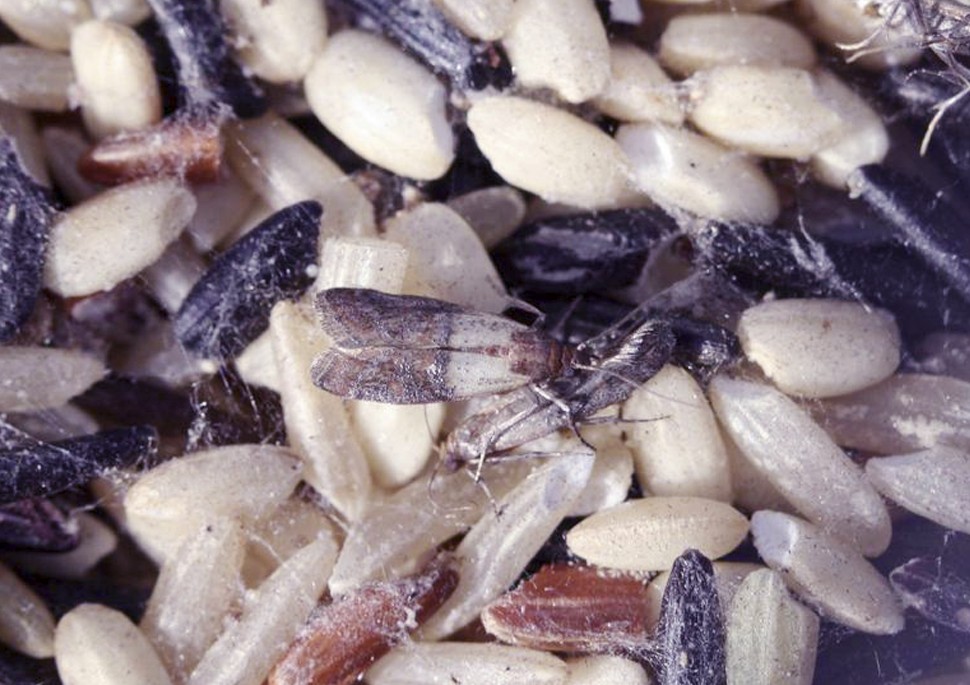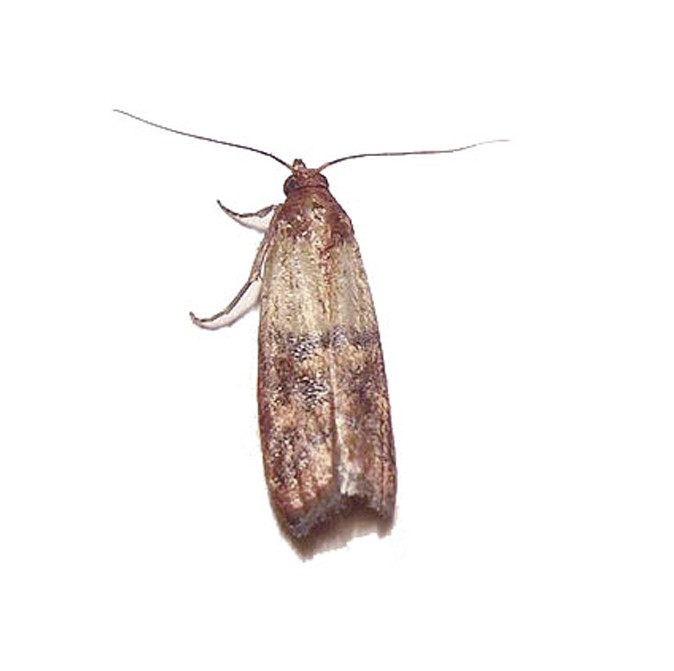Indian Meal Moth
What are Indian Meal Moths?
The Indian meal moths are one of the most commonly found pests in kitchens and pantries that you probably don’t know by name. Before reading this article, chances are you spotted these moths and gave them the nickname like “pantry moths” or “flour moths.”

If you have ever witnessed an infestation in your kitchen or pantry, possibilities are that your culprit is the nasty Indian meal moths who love to feed on dry food items like grains, flour, rice, pet food, candies, seeds, etc. They can act as an infestation machine; therefore, it’s essential to understand these bugs a little better. Now without further ado, let’s dive into the world of the Indian meal moths.
The Appearance of Indian Meal Moths
The eggs of the Indian meal moths are usually grayish-white and 0.3-0.5 mm long in size. The larvae are typically off-white. However, there might be shades of pink, green, and brown on their body. They can move using their prolegs. The adults have an elongated oval-shaped body and are 3/8 of an inch long. However, upon stretching their wings fully, they appear approximately 5/8 of an inch long.
Identification

It’s quite easy to identify the Indian meal moths from their irregular, zigzag flying pattern. They are nocturnal and remain active during the night. These moths are attracted to light sources, including your television. You can spot these bugs resting on the walls, crevices, ceilings, and in areas where the lighting is dim.
The Behavior of Indian Meal Moths
Indian meal moths are nocturnal, and they only fly during the night. The irony is that regardless of their nocturnal nature, Indian meal moths are attracted towards light sources and therefore also considered as phototactic. There are many theories to support this, and according to one such theory, these moths acknowledge moonlight as a reference which helps them to move in a straight direction. They come towards your house because the moths tend to confuse light sources for moonlight and consider the house lights as their ultimate reference point to move in the right direction.
The Indian meal moths mostly reproduce and remain active during warm seasons when the temperature remains above 50 degrees Fahrenheit. During winters, these moths stay in their safe infested zones.
These nasty bugs like to lay their eggs in dry food items including pet food, dry fruits, flour, grains, powder milk, cereals, and even candies. These moths usually make a lot of webs in the food that they infest, so it’s always suggested to check packaged food before buying from the market. The larvae of the Indian meal moths are generally found at a distance from the infested food as they move to a darker area in order to pupate.
In terms of mating behavior, these moths mate with multiple partners. The adult female Indian meal moths release pheromones to attract the male moths. After approaching the female moth, a male releases pheromones indicating a female to stay stationary if she too wants to mate with him.
Lifecycle
The life cycle of Indian meal moths goes through four stages – Egg, Larvae, Adult, and Diapause. An adult female moth is capable of laying from 100 to 400 eggs at a time, and it takes from 25 to 135 days for the eggs to develop into adults. A lot depends on the temperature and climatic conditions also. These moths take from 5 to 6 weeks to fully grow into adults when the temperature is above 50-65 degrees Fahrenheit.
- Eggs – The females lay upto 100-400 eggs during their short life span. These eggs can be laid all at once or in batches of 12-30 eggs. The eggs are impossible to see through naked eyes, and you might need to use a microscope to spot them.
- Larvae – It takes the larvae from one-two weeks in order to hatch. They usually have 5-7 instars. The larvae are the most damage causing form of the Indian meal moths as they feed on grains, flour, dry fruits, pet food, and even candies. Not only this, the larvae leave webs and silk threads over the packaged food that they damage.
- Adults – The moths remain inactive during the pupa stage and do not cause any damage. The pupae are covered in silk cocoons and take from 4-10 days to develop into adults fully. Once, the pupae become adults, they start mating, and the entire cycle repeats all over again. It’s important to know that the adults are short-lived from five to seven days.
- Diapause – Diapause is a period of time for which the development of an insect/ animal is delayed due to unfavorable climatic conditions. Diapause is also seen in Indian meal moths. There can be a postponement in hatching if the temperature goes beyond 77 degrees Fahrenheit during the egg stage. A similar diapause can occur if the temperature goes below 68 degrees Fahrenheit.
Eating Habits of Indian Meal Moths
Before learning about the eating habits of the Indian meal moths, first, it’s essential to know that the adult population of these nasty insects does not eat. Since their life cycle is short, these moths only survive enough to be able to copulate and reproduce. However, they eat consistently during the larval stage, where most of the damage is done. So, if you spot the adult Indian meal moths in your dry food containers, there could be two reasons why it’s there. Either they have just transformed into the adults or came there to lay eggs.
The larvae which cause most of the damage love to eat dry pet food, rice, flour, pasta, seeds, bread, dry fruits, cereals, spices, grains, corn, maize, powdered milk, crackers, candy, chocolates, and soup mixes.
Since the Indian meal moths easily get inside even the tightest containers, there is a high possibility that the packaged food you just bought from the store is already infested. Not only this, but these awful bugs also like to chew cardboard and thin plastic bags.
How to Get Rid of Indian Meal Moths?
During the first two stages, the Indianmeal moth looks similar to quinoa or brown rice grains. Hope you know what we’re getting at. Yes, chances are you already have tasted and eaten them before. Gross, isn’t it? Don’t forget the distaste; it will help you stay motivated to try these proven remedies to get rid of the Indianmeal moth entirely:
Regular Vacuum
Using a vacuum will go a long way in removing spilled food on the carpets, sofas or even bedding, especially if you have kids or pets. People tend to get careless with dropping foodstuff here and there which turns out to be a significant source of food for the Indian meal moths.
Light up your house
Indian meal moths like to hang around in darker spaces. Light up your home to keep these disgusting pests at bay while you’re cleaning the house thoroughly.
Pheromone traps
The sticky pheromone traps are used to attract and trap the Indian meal moths. However, the downside of these traps is that they are only capable of catching the adult male moths. The females are responsible for laying eggs and multiplying the moths’ population so the traps can sometimes be inefficient in controlling the infestation.
Reduce clutter
Having too much furniture in your home might be problematic as the area will be challenging to clean. If all the clutter is not of use, then it is just consuming your time and providing a comfortable home for the nasty Indian meal moths. Sell off the stuff that you don’t use, or you can also give some things like a charity.
Use soap water
Wash the infested areas with soap and water to kill the eggs and larvae so that they don’t grow up into adults and increase their population.
Vinegar
If you spot an area that is infested by Indian meal moths, wipe it with vinegar to kill the eggs and larvae. Vinegar does not just kill the moths but any other pest or insect that is creating nuisance in your house.
Seal the cracks and crevices
Your home might have many such corners, cracks, and crevices that you are not aware of but the moths live comfortably there. You need to first identify the cracks and gaps in order to seal them using the concrete patch, silicone caulk, or spray foam. So that you know all these items are readily available on any nearby hardware shop.
Freeze and Store
To prevent re-infestation, keep the dry goods in the freezer for about one to two days before storing them in containers. Later, follow the foodstuff in airtight containers or glass jars. This would keep the moths away, and even if they manage to get inside the jars, they can’t cause further infestation as they would never be able to come out of the containers.
Other tips:
- Always look for holes or webbings in the packaged food items before purchasing.
- To stop the moths from reaching their larval stage, release Trichogramma wasps.
- Improve cleaning habits
- Take professional help if the methods mentioned above are not helping.
Pictures
Take a look at these Pictures of Indian meal moths to get to know more about their appearance:




Interesting Facts
- The Indian meal moths can be easily part in any part of the world except Antarctica.
- The scientific name of the Indian meal moth is Plodia interpunctella, and they come from the family of Pyralidae.
- The predators of Indian meal moths include birds, bats, and owls, Rodents, Cats, Bear, Dogs, and Lizard.
- These moths tend to practice cannibalism by eating their own larvae. However, unlike other species, they only eat healthy larvae instead of the sick ones because they fear to fall sick by consuming the weak young ones.
- About seven to nine generations of a moth can survive in a span of just one year.
